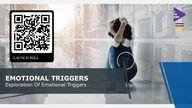
Return to flip book view
EMOTIONAL TRIGGERSExploration Of Emotional Triggers
Rules around emotions go unspoken but are quickly learned.There are typically consequences if an emotional rule is violated.Emotions in the ClassroomWhy are they important to understand?
A trigger is anything that brings forth a memory or emotional reaction.These feelings or memories affect how you react to the situation.What are Emotional Triggers?
Emotional TriggersResponses to triggers are influenced by:• Experience (internal context)• Evolution (societal context)• Genetics (physical context)• Environment (ambient context)Each trigger has a root cause, and it may take several triggers to cause a reaction.
Why Do We Get Triggered?Opposing beliefs and valuesWe suffer from emotional triggers for three main reasons: Trauma Ego preservation
Opposing Beliefs and Values• When we strongly identify with a certain belief, we may find it hard to be tolerant of other opposing beliefs. • Values stem from beliefs and involve what we hold as important in life. • We may be triggered when our values are called into question.
Trauma Triggers• “Triggered” is a term that traces back to the experiences of the past.• We are triggered due to past traumatic experiences. Our reaction is often extreme fear and panic (or in some cases, anger).
Ego PreservationThe Ego: • Is composed of thoughts, memories, cultural values, assumptions, and belief structures developed in order to fit into society• Protects by developing self-protection mechanisms in the form of beliefs, ideals, desires, habits, and addictionsWhen our ego is challenged or hurt by others, we are prone to becoming triggered.
What is a “Moment of Truth”?The split second when you become aware of a trigger and you decidehow to react.
Why it Matters?Knowing what is causing you to have an experience of an emotional trigger will allow you to take a step back, and decide your response.
Possible Reactions to the Trigger Could Be…• Anger• Pity• Sadness• Shame• Guilt• Defensiven ess• Hostility• Frustration• Overwhelm• Fear
Signs of Being Emotionally Triggered• Trembling • Palpitations/racing heart • Choking feeling or trouble breathing/swallowing • Hot flashes, chills• Dizziness or faintness • Chest pain/discomfort • Feeling of detachment/unreality (known as dissociation)
AAThe Trigger Thought ProcessMost people believe that Event A causes Reaction BBAIn reality, the thought process is Event (A) triggers Stories, Beliefs, Values andEmotions (B), which lead us to choose Reaction (C)AAB CA
WHAT CAUSES EMOTIONS?• Emotions are affected by the way we appraise a situation• Positive or negative bias influences our thoughts• Our thought patterns are often learned and habitual• These thought patterns can be interrupted through self-awareness and shift in perception
Crisis Events Can Create a CycleFear and Anxiety Creates StressAttention on the Event with a Negative Bias Negative Thoughts ActionsBad News or Experience
The Cycle Can Be Interrupted Fear and Anxiety Creates StressAttention on the Event from a Negative to Positive Bias Positive Thoughts ActionsBad News or ExperienceChange your bias to interrupt the cycleZOOM INChange PatternIntentional Actions
Identify TriggersChallenge Your MotivesTwo-Step Approach1 2
Identifying TriggersWe have all been in situations where our emotions can get the best of us.Think back to a recent situation where your emotions impacted your behavior.
Common Situations That Trigger Intense Emotions Include…• Rejection• Betrayal • Challenged beliefs• Helplessness or loss of control• Being excluded or ignored• Disapproval or criticism• Feeling unwanted or unneeded• Insecurity
Pay Attention to Your Body Learning to recognize your triggers involves paying attention when situations create a strong emotional response.You might experience some physical symptoms such as: Pounding heartUpsetstomachShakiness or dizzinessSweaty palms
Identify TriggersChallenge Your MotivesTwo-Step Approach1 2
Relationship-Building MotivesRelationship-Destroying MotivesChallenge Your MotivesProduce greater resultsProve somethingStrengthen relationshipsPunish or blameLearn the truthWin
What do I want in situations like this?21What steps should I take right now to move towards what I want?Trigger Mindset
Retraining Triggers is an ARTAfter discovering your negative personal triggers, you can change them.ARTAWAREREGULATETRAIN